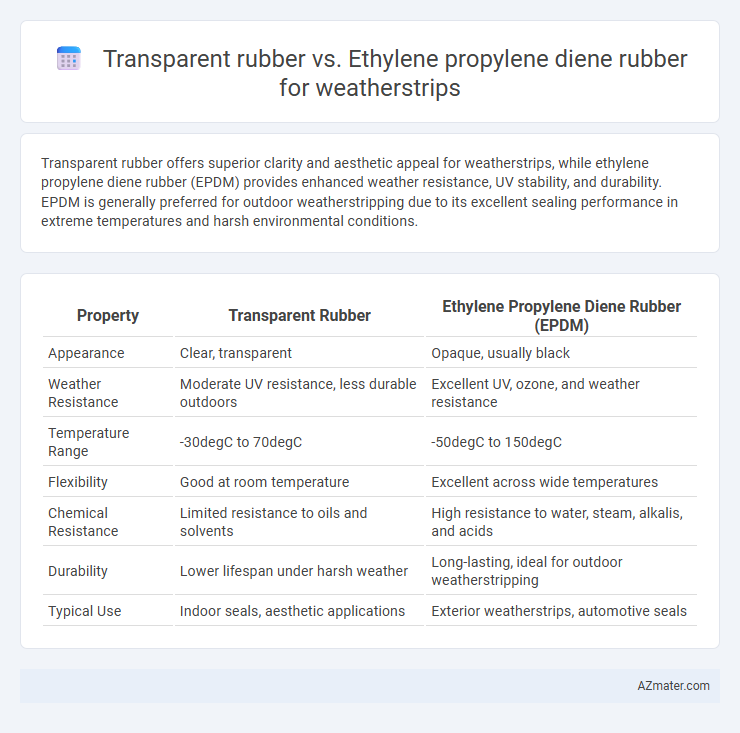Transparent rubber offers superior clarity and aesthetic appeal for weatherstrips, while ethylene propylene diene rubber (EPDM) provides enhanced weather resistance, UV stability, and durability. EPDM is generally preferred for outdoor weatherstripping due to its excellent sealing performance in extreme temperatures and harsh environmental conditions.
Table of Comparison
| Property | Transparent Rubber | Ethylene Propylene Diene Rubber (EPDM) |
|---|---|---|
| Appearance | Clear, transparent | Opaque, usually black |
| Weather Resistance | Moderate UV resistance, less durable outdoors | Excellent UV, ozone, and weather resistance |
| Temperature Range | -30degC to 70degC | -50degC to 150degC |
| Flexibility | Good at room temperature | Excellent across wide temperatures |
| Chemical Resistance | Limited resistance to oils and solvents | High resistance to water, steam, alkalis, and acids |
| Durability | Lower lifespan under harsh weather | Long-lasting, ideal for outdoor weatherstripping |
| Typical Use | Indoor seals, aesthetic applications | Exterior weatherstrips, automotive seals |
Introduction to Weatherstrip Materials
Weatherstrip materials like transparent rubber and Ethylene Propylene Diene Monomer (EPDM) serve critical roles in sealing applications to prevent air, water, and dust infiltration. Transparent rubber offers excellent clarity and flexibility, ideal for applications requiring visibility and aesthetic appeal, while EPDM is renowned for its superior weather resistance, ozone tolerance, and durability in extreme temperatures. EPDM's molecular structure provides enhanced elasticity and long-lasting performance, making it a preferred choice for automotive and architectural weatherstripping.
Overview of Transparent Rubber
Transparent rubber offers exceptional clarity and weather resistance, making it ideal for applications requiring visibility and durability, such as weatherstrips in automotive and architectural industries. Its elastomeric properties ensure flexibility and a tight seal against environmental elements, while maintaining UV stability and resistance to ozone degradation. Compared to Ethylene Propylene Diene Monomer (EPDM), transparent rubber provides superior aesthetic appeal and clarity, though EPDM excels in broader chemical resistance and temperature tolerance for heavy-duty weatherstripping needs.
Key Properties of Ethylene Propylene Diene Rubber (EPDM)
Ethylene Propylene Diene Rubber (EPDM) exhibits exceptional weather resistance, making it ideal for weatherstrip applications exposed to prolonged sunlight, ozone, and moisture. Its outstanding flexibility and excellent heat resistance ensure durability in extreme temperature variations, ranging from -40degC to 150degC. High resistance to oxidation, UV degradation, and aging distinguishes EPDM from transparent rubber, which generally provides less durability in outdoor environments.
Weather Resistance Comparison
Ethylene propylene diene rubber (EPDM) outperforms transparent rubber in weather resistance for weatherstrip applications due to its superior resistance to UV radiation, ozone, and extreme temperatures ranging from -40degC to 150degC. Transparent rubbers like silicone or polyurethane, while offering good clarity, often exhibit lower durability when exposed to prolonged sunlight and harsh weather conditions, leading to faster degradation and loss of elasticity. EPDM's excellent retention of mechanical properties and minimal swelling in moisture-heavy environments make it the preferred choice for long-lasting weatherstripping solutions.
UV and Ozone Protection Capabilities
Ethylene propylene diene rubber (EPDM) offers superior UV and ozone resistance compared to transparent rubber, making it ideal for weatherstrip applications exposed to harsh environmental conditions. EPDM's molecular structure provides excellent durability against ozone cracking and UV degradation, extending service life significantly. Transparent rubber, while visually appealing, typically lacks the robust protective capabilities required for long-term outdoor exposure.
Flexibility and Durability Analysis
Transparent rubber offers superior flexibility for weatherstrip applications, enabling it to conform tightly to varied surfaces and maintain an effective seal under dynamic movements. Ethylene propylene diene rubber (EPDM) exhibits exceptional durability due to its outstanding resistance to UV radiation, ozone, and extreme temperatures, making it ideal for prolonged outdoor exposure. While transparent rubber excels in aesthetic adaptability and pliability, EPDM outperforms in long-term resilience and mechanical integrity in harsh environmental conditions.
Aesthetic and Design Considerations
Transparent rubber offers superior aesthetic appeal for weatherstrips by providing a clear, unobtrusive finish that seamlessly blends with various surfaces, enhancing design versatility. Ethylene propylene diene rubber (EPDM) excels in weather resistance and durability but typically comes in opaque colors, potentially limiting design integration in visually sensitive applications. Choosing transparent rubber improves visual subtlety and design cohesion, whereas EPDM prioritizes functional longevity over aesthetic flexibility.
Cost and Manufacturing Differences
Transparent rubber offers aesthetic advantages and allows for easy visual inspection but generally has a higher material cost compared to ethylene propylene diene monomer (EPDM) rubber used in weatherstrips. EPDM rubber is more cost-effective, widely available, and excels in weather resistance and durability, making it the preferred choice for mass production in weatherstripping applications. Manufacturing transparent rubber involves specialized processes to maintain clarity, whereas EPDM manufacturing is simpler, with faster curing times and suitability for large-scale extrusion or molding.
Environmental Impact and Sustainability
Transparent rubber used in weatherstrips often relies on synthetic polymers that may involve higher fossil fuel consumption and limited recyclability, leading to a larger environmental footprint. Ethylene propylene diene monomer (EPDM) rubber is known for its excellent weather resistance, durability, and potential for longer lifecycle, which contributes to reduced waste and enhanced sustainability in automotive and construction sealing applications. EPDM's formulation allows for better resistance to UV radiation and ozone degradation, minimizing replacement frequency and thereby supporting environmental conservation efforts through resource efficiency.
Choosing the Right Weatherstrip Material
Selecting the right weatherstrip material requires comparing transparent rubber and ethylene propylene diene monomer (EPDM) rubber based on durability, UV resistance, and flexibility. Transparent rubber offers excellent clarity and aesthetic appeal but may lack the long-term weather resistance essential for outdoor applications. EPDM rubber excels in resisting extreme temperatures, ozone, and weathering, making it the preferred choice for durable, efficient weatherstripping in automotive and architectural sealing.

Infographic: Transparent rubber vs Ethylene propylene diene rubber for Weatherstrip
 azmater.com
azmater.com